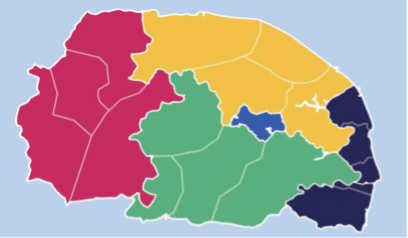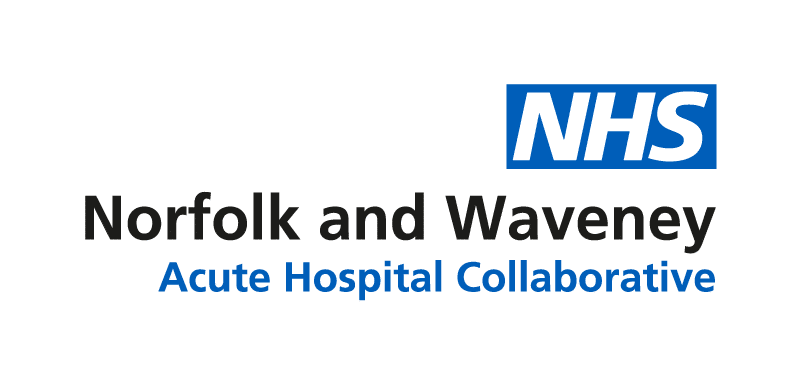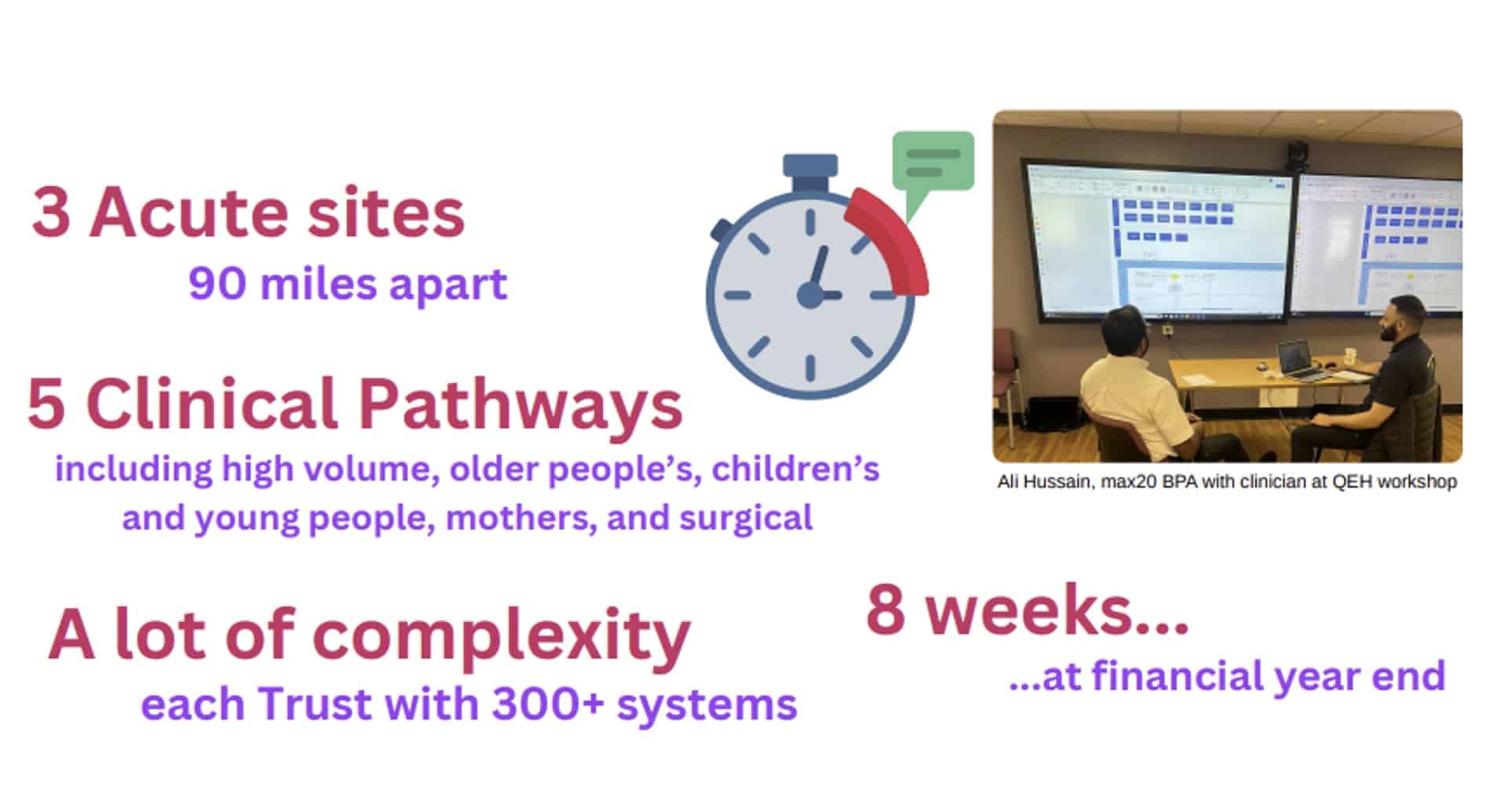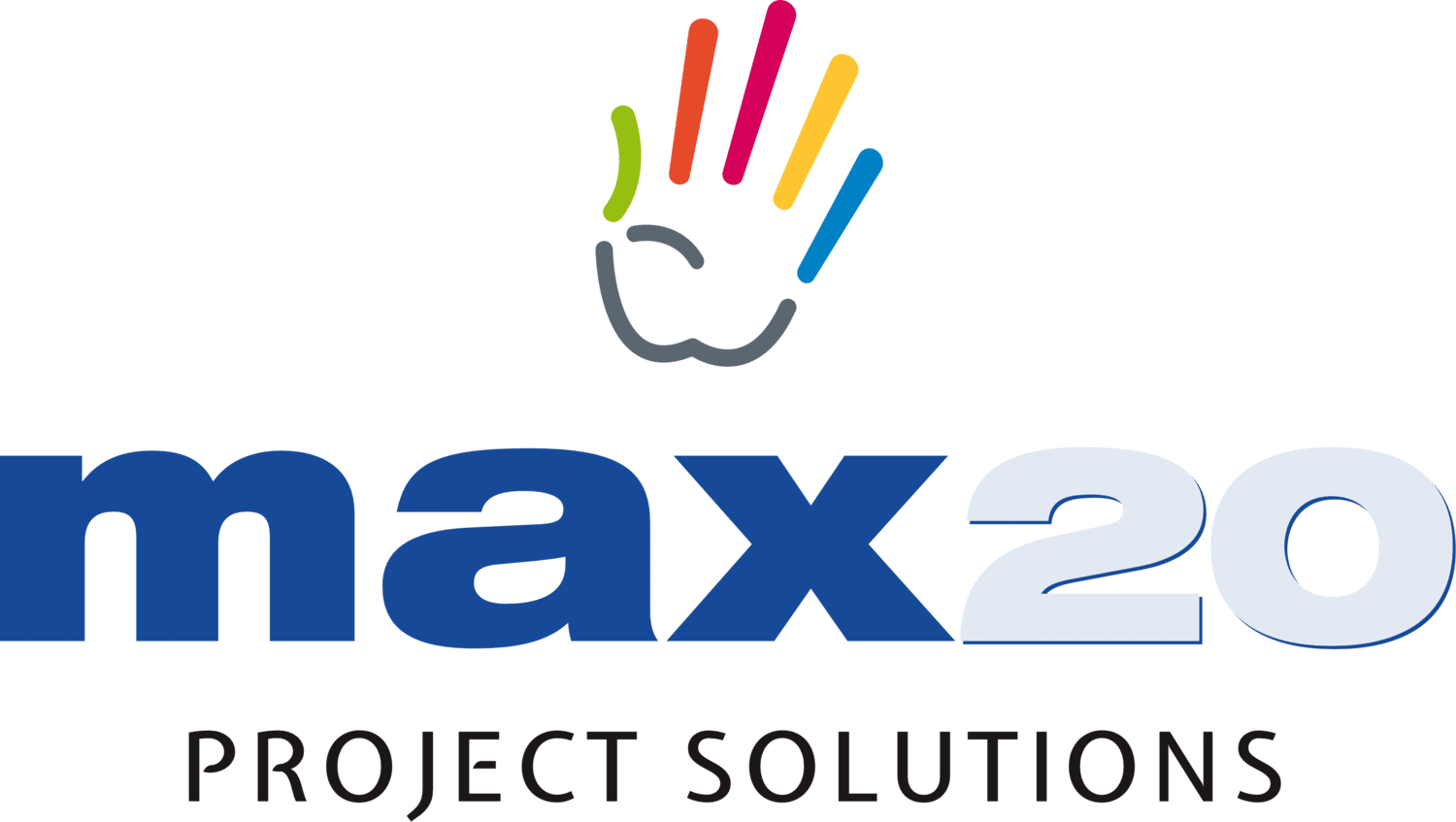Case Study
Norfolk and Waveney Acute Hospital Collaborative
Documenting existing workflows to support user-centric design for EPR planning. Programme delivery by max20 Project Solutions


This is the account of a Current State Assessment Project, deploying a user-centric as-is process mapping method for Norfolk and Waveney Acute Hospital Collaborative, with max20 Project Solutions
Below you will find the details of how max20 Project Solutions and Norfolk and Waveney Acute Hospital Collaborative worked together to ensure user-centric design is at the heart of EPR planning. In order to do this effectively, they started with a “current state assessment” project, which max20 Project Solutions completed within an 8-week period, the analysis of which was to feed directly into the EPR design.
Key Highlights:
-
Rapid mobilisation of 8-strong project team within 10 days.
- Implementation of a business process analysis approach to augment and support existing change function within Trusts.
- Use of a rapid-agile delivery method focusing each identified clinical specialty to ensure deeper insights and comparison across organisations
- Fast-paced delivery of current state assessment in 8 weeks.
- Trusts were provided with a legacy inclusive of 16 reports
- Production of a handover kit of key templates, user-centric question bank and guidance to support the continued upskilling of existing staff
- Provision of an in-depth cultural analysis for future transformation planning
In numbers:
- 133 user-centric staff contacts made with clinical and administrative staff across the three organisations.
- 251 processes identified.
- 199 processes mapped and handed over.
- 16 reports produced.
- 184 additional processes drafted across Trust sites.

Norfolk and Norwich University Hospital

James Paget University Hospital

Queen Elizabeth Hospital, Kings Lynn
The Challenge
A single consolidated view of processes across three disparate acute hospital trusts
The Norfolk and Waveney Acute Hospital Collaborative (NWAHC), comprising James Paget University Hospital, Norfolk and Norwich University Hospital and Queen Elizabeth Hospital King’s Lynn, aims to enhance patient care and staff experience through close collaboration, while maintaining separate cultural and environmental identities. Nevertheless, their vision is to deliver high-quality hospital care, tailored to meet patient needs across the East Anglia health system. By pooling resources and expertise, each organisation strives to optimise efficiency and effectiveness in healthcare delivery for their patients and staff. Their unified Electronic Patient Record (EPR) programme is aimed at expediting diagnosis and treatment, particularly for cancer patients, ultimately improving access to care and reducing waiting times.
Despite being separate acute organisations spanning East Anglia, they aim to achieve consolidated workflows tailored to meet the core needs of all their users. The Trusts identified the best way to design a system fit for their staff would be through a user-centric design approach.
The Trusts recognised that the challenges inherent in their ambitious programme is intensified by a variety of complexities:
• varied cultures and practices
• different approaches to patient record management
• a mixture of digital maturity across organisations and staff groups.
Through collaborative staff engagement and upskilling efforts, the Trusts envisioned comprehensive benefits from a “current state assessment” project, aiming for a head-start on process mapping activities across clinical specialties within an 8-week timeframe.
Ultimately, this current state analysis was to feed into their EPR design, and it was essential for each organisation to gain insights into existing workflow challenges, differences, and similarities.
“A major challenge in this process was the tight-timeline; the current state assessment was to be completed within an eight-week window for funding considerations and to coincide with the end of the financial year, plus accounting for annual leave, bank holidays, and staff availability at peak times.”

The Solution
Delivering user-centric discovery through process mapping
NWAHC partnered with max20, leveraging their extensive experience in healthcare project solutions to execute the Current State Assessment Project (CSA project). max20 deployed user-centric as-is process mapping methodology, which involved thoroughly understanding and documenting existing workflows from the perspective of the individuals who directly engage with them.
In interviews, workshops, and observational journeys, the agile max20 team, comprising a Project Director and 5 Business Process Analysts, focused on capturing and analysing the real experiences, needs, and challenges of users involved in each step of a process, including both clinical and administrative staff. Process analysis and mapping prioritised empathy and collaboration, ensuring that the resulting process maps accurately reflected the intricacies of day-to-day operations and the true effort of front-line health staff. Process mapping sessions focused on deep elicitation methodology, gathering pain-points, and analysing them against the overall environmental context.
“The transparency among user groups was commendable and displayed a deep devotion to patient care. When relaying challenges or good practice, it was evident that providing outstanding patient care was at the core of every action. There was no shame in improvement; teams readily welcomed ideas to improve practices.”
max20 implemented a rigorous operational framework, including daily stand-ups and robust internal governance controls, ensuring consistency and shared decision-making across Trusts. By establishing a close joint-working framework across organisations, max20 and NWAHC were able to develop a shared vision, ensuring alignment across the EPR programme.
“Each week, max20 set clear goals and communicated them to all team members, fostering a focused and goal-oriented environment.”
max20 Project Solutions & Outcomes
When NWAHC were looking for an experienced and comprehensive partner for this Current State Assessment Project (CSA project) to support their EPR design, they knew they could rely on max20 delivering results in the tight timescale specified.
The Outcomes
16 reports and a handover toolkit to offer ongoing upskilling of staff
max20 facilitated several knowledge exchange sessions, produced five clinical specialty specific analysis for each organisation (a total of 15 reports) and provided an overall report delving into the cultural context of each organisation.
These efforts were instrumental in ensuring a legacy to support substantive staff in future phases of the EPR programme. Staff were equipped with essential insights and governance frameworks that would assist in optimising their operational roles through actionable recommendations for overcoming challenges. The detailed reports for each clinical specialty, tailored to the organisations culture, were designed to support ongoing user-centric process mapping activities and future-state design.
Noteworthy outcomes include the rapid creation of a full current state assessment project, drafting of 184 additional processes, and the production of 16 reports. Additionally, the handover toolkit and in-depth cultural analysis further bolstered the success of the EPR design, enabling continued upskilling and future transformation planning at all levels within each organisation.
“Our structured and interactive knowledge exchange sessions helped play a pivotal role in advancing the EPR project, ensuring that all staff involved were aligned and equipped with the necessary insights and governance frameworks to optimise their operational roles.”




